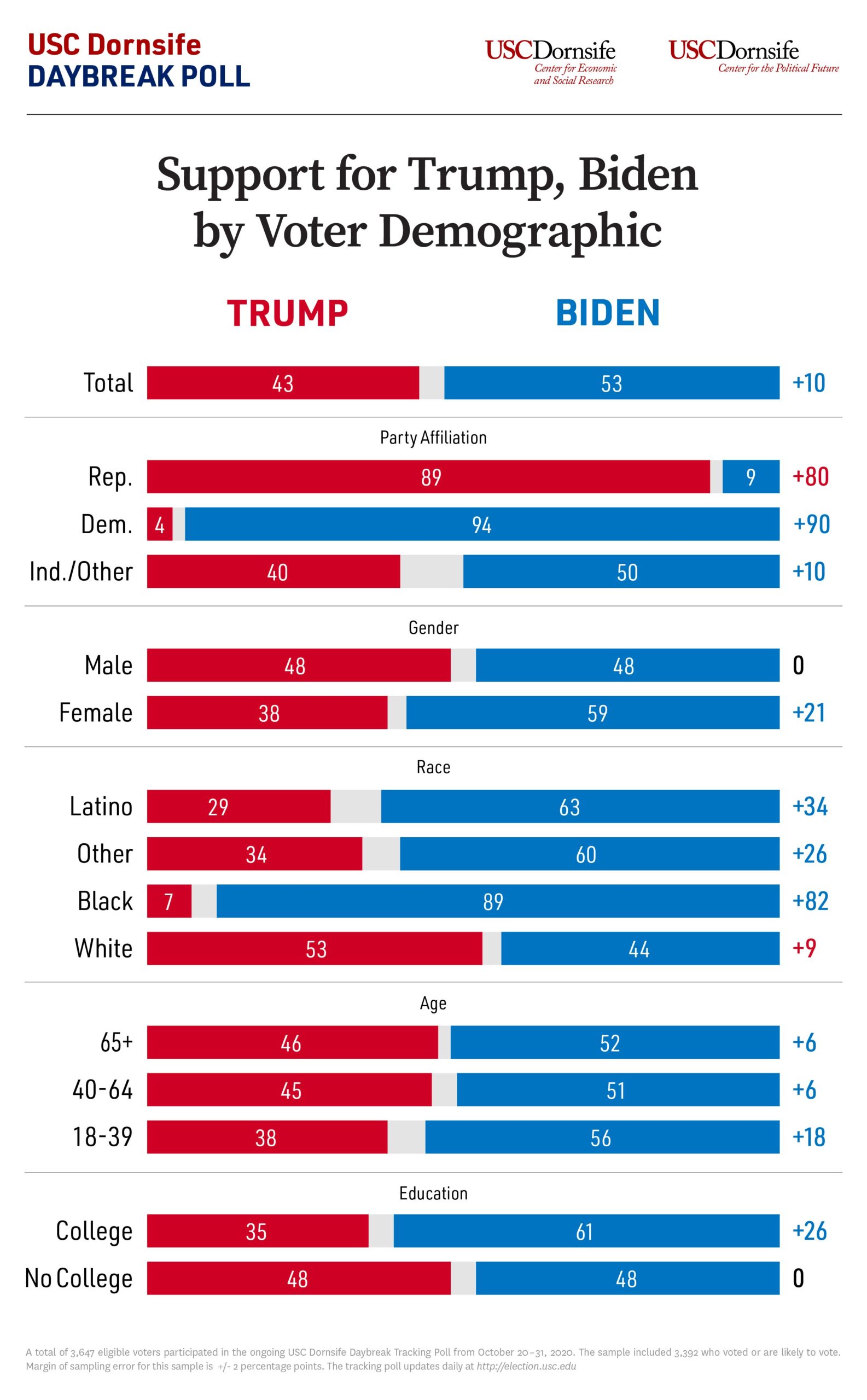
Final USC Dornsife Daybreak Poll reveals stable presidential race; Biden leads Trump
The final USC Dornsife Daybreak Poll before the general election confirms that the presidential race has remained stable — despite the chaotic backdrop of an election season coinciding with a global pandemic, racial unrest, continued economic uncertainty, corruption allegations and a president infected with the coronavirus.
The poll, which tracks the national popular vote, shows former Vice President Joe Biden with a 10-point lead over President Donald Trump. This has narrowed slightly since the days after the first debate, when Biden had a 13-point lead over Trump.
The poll is not able to provide estimates of the electoral college vote, which takes place at the state level and will determine the outcome of the election.
“For me, the big news here is no news,” said Bob Shrum, director of the Center for the Political Future at the USC Dornsife College of Letters, Arts and Sciences.
“The race remains remarkably stable and if all the ballots are received and actually counted, Joe Biden is likely to win the popular vote by 9 to 11 points.”
The national probability poll was conducted online from Oct. 20–31 by the USC Dornsife Center for Economic and Social Research. Participants are members of the center’s Understanding America Study panel. The poll’s margin of sampling error is plus or minus 2–3 percentage points.
Comparison of 2016 and 2020 vote
Overall, Biden has a distinct advantage in the poll’s measurement of the popular vote compared to Hillary Clinton’s final 2016 margin of roughly 2 percentage points over Trump.
Biden is benefiting from the support of some key demographic groups that were more likely to vote for Trump in 2016 than his Democratic opponent, including seniors, rural voters and those without college degrees.
The president has also lost ground among men, whites and “other” voters, mainly Asian American and Native American. White women, who voted for Trump over Clinton by 9 percentage points in 2016, are currently giving Biden a 2 percentage point edge, within margin of error for that group.
“I’m particularly struck by what I would now call the hidden Biden voters — the non-college-educated women who are voting in greater numbers for Biden than we would have expected based on the 2016 results,” said Shrum.
Who’s voting early, and who’s waiting for Election Day
As of Oct. 31, more than 30% of poll participants had already voted by the time they were surveyed. Just under half of those voters had mailed a ballot.
Just over 30% of voters who had not yet voted were planning to vote early in person or drop off a mail ballot, a little more than 15% were planning to mail a ballot and well over a third said they planned to vote in person on Election Day, which can include returning a mail ballot.
Among early voters, Biden has a 2–1 lead, which is attributable to the higher proportion of Democrats casting their votes before Election Day.
While each candidate has the vast majority of the vote among their party members who voted early, Biden holds a wide lead among independents at 59% to 35%. He received nearly one-quarter of the vote among independents who lean Republican.
Trump received only 4% of the vote among independents who lean Democrat.
“If Biden’s 2-to-1 lead in our poll holds among early voters, Trump would need a much wider lead among those who vote in person on Election Day than he holds now to win the popular vote,” said Jill Darling, survey director of the Daybreak Poll. “The stakes are high regarding whether all mail-in votes will be counted, and whether voters will show up at the polls and be able to cast their votes.”
As it stands now, according to the poll, just under half of the voters showing up at the polls on election day will be Republicans, more than a quarter will be Democrats and another 1 in 5 will be independents.
“We may have a red mirage on Election Day, depending on how the television networks handle their exit polling of absentee ballots,” said Mike Murphy, co-director of the USC Dornsife Center for the Political Future. “If the media just reports county returns in Pennsylvania, Michigan and Wisconsin, Trump’s going to take an early lead and hold it for a while because none of those states start counting their absentee ballots until Election Day.”
Chances of an election challenge, and of violence?
Participants answered two new questions in the latest poll: one about the likelihood that the candidates would challenge the election’s outcome and the other about the likelihood of violence based on a Trump or Biden victory.
Voters rated the likelihood of Trump challenging the election outcome in a Biden Electoral College win at 72 out of 100, and put the likelihood at 49 of Biden challenging the election outcome.
Trump supporters rated the likelihood of a Trump challenge and of a Biden challenge equally.
Biden supporters as well as independents rated the likelihood of a Trump challenge far higher than a Biden challenge.
Overall, voters rated the likelihood of violence after the election at 46 out of 100 if Biden wins and 58 out of 100 if Trump wins.
Up next: post-election questions
The day after the election, the USC Dornsife Daybreak Poll will be back in the field with questions about who actually voted and how that compares to pre-election estimates.
Additionally, pollsters will ask about QAnon, Antifa and conspiracy theories during the election cycle.
About the USC Dornsife Daybreak Poll
The USC Dornsife Daybreak Poll 2020 is conducted by the USC Dornsife Center for Economic and Social Research, in partnership with the USC Dornsife Center for the Political Future.
For more details about the Daybreak Poll and the current results, see USC News >>
